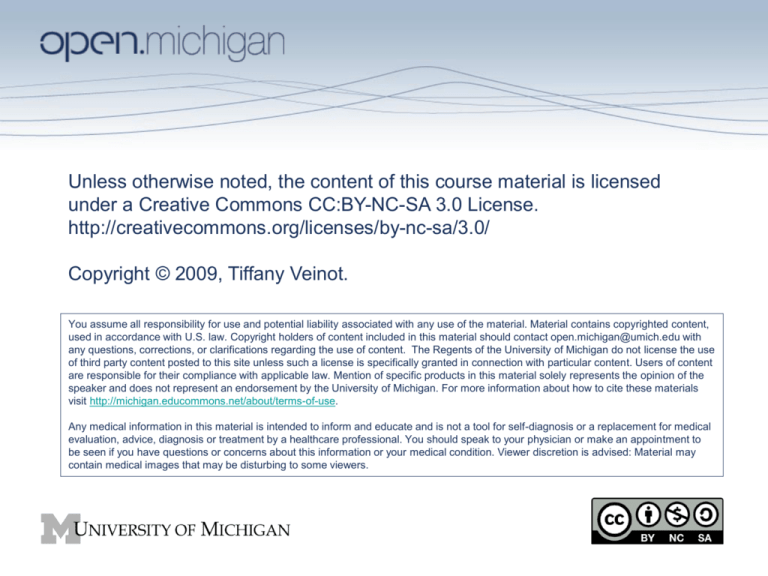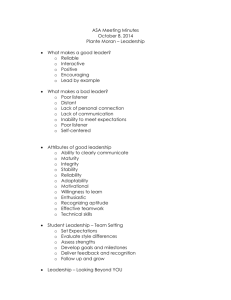SI626-W09-Week8 - Open.Michigan
advertisement

Unless otherwise noted, the content of this course material is licensed under a Creative Commons CC:BY-NC-SA 3.0 License. http://creativecommons.org/licenses/by-nc-sa/3.0/ Copyright © 2009, Tiffany Veinot. You assume all responsibility for use and potential liability associated with any use of the material. Material contains copyrighted content, used in accordance with U.S. law. Copyright holders of content included in this material should contact open.michigan@umich.edu with any questions, corrections, or clarifications regarding the use of content. The Regents of the University of Michigan do not license the use of third party content posted to this site unless such a license is specifically granted in connection with particular content. Users of content are responsible for their compliance with applicable law. Mention of specific products in this material solely represents the opinion of the speaker and does not represent an endorsement by the University of Michigan. For more information about how to cite these materials visit http://michigan.educommons.net/about/terms-of-use. Any medical information in this material is intended to inform and educate and is not a tool for self-diagnosis or a replacement for medical evaluation, advice, diagnosis or treatment by a healthcare professional. You should speak to your physician or make an appointment to be seen if you have questions or concerns about this information or your medical condition. Viewer discretion is advised: Material may contain medical images that may be disturbing to some viewers. SI 626 – Management of Libraries and Information Services Class Eight: HR wrap-up; Team Work & Leadership Overview • • • • • Supervision (conclusion). Performance management (conclusion). Team Work. Leadership. Conclusion. Supervision • Learning Objectives – To develop an understanding of principles and techniques of employee supervision. – To promote critical thinking and reflexivity about the practice of employee supervision. Supervision • Communication and coordination • Delegation • Motivation • Mentoring Motivation • “...the willingness to expend energy to achieve a goal or reward.” (Stueart & Moran, 2007, p.304) • Indicators of motivation: – engagement; – satisfaction; – commitment; and – intention to quit. (Nohria, Groysberg & Lee, 2008, p.80) Motivation • Mini-paper: – Write about a time when you felt especially motivated to accomplish a work-related goal. Reflect upon the following questions: • What was the goal? • Did your level of motivation affect the ways in which you worked? If so, how? • Why were you motivated? Motivation • Content theories of human motivation: – Maslow’s Hierarchy of Needs (1970). • physiological + safety/security + social/affiliational + esteem + self-actualization. – Nevis’s Chinese Hierarchy of Needs (1983). • Belonging + physiological + safety + selfactualization. (Stueart & Moran, 2007) Motivation • Content theories of human motivation: – Herzberg’s Two-Factor Theory of Motivation (1959). • Maintenance: salary + job security; working conditions + interpersonal relations; supervision – Lead to dissatisfaction, but not motivation. • Motivational: advancement; recognition + work itself; achievement; responsibility. – Lead to true motivation. – Job enrichment model. (Stueart & Moran, 2007) Motivation • Content theories of human motivation: – McClelland’s Need Theory (1961). • Achievement: drive to excel and succeed. – Want to assume responsibility. • Power: desire to have an impact and be influential. – Want to be in charge. • Affiliation: desire for close interpersonal relationships. – Want cooperation. (Stueart & Moran, 2007) Motivation • Content theories of human motivation: – Four Drives Theory (2008). • Drive to acquire: improves feelings of well-being. This drive is relative and insatiable. • Drive to bond: positive emotions; feeling of belonging to an organization or work unit. • Drive to comprehend: invigoration from the challenge of working out answers. • Drive to defend: when satisfied – feelings of security and confidence. (Nohria, Groysberg & Lee, 2008) Motivation • Mini-paper – part 2: – Can you explain your motivation with the help of any specific content theories of human motivation? • • • • Hierarchy of Needs Two-Factor Theory Need Theory Four Drives Theory Motivation • Process theories of human motivation: – Adams’s Equity Theory (1963). • People compare their efforts & rewards to others, and seek balance. – Vroom’s Expectancy Theory (1964). • Individuals act to maximize positive results, minimize negative results. • Force = Valence X Expectancy X Instrumentality (Stueart & Moran, 2007) Motivation • Process theories of human motivation: – Behaviour modification theory (1953). • Positive and negative reinforcement. • No reinforcement or punishment. – Goal setting theory (1978). • Set specific and challenging goals, give feedback. – Organizational support theory (1986). • Belief that: one is treated fairly; one’s supervisor supports them; favorableness of rewards and favorableness of job conditions. (Rhoades & Eisenberger, 2002; Stueart & Moran, 2007) Motivation • Mini-paper – part 3: – Can you explain your motivation with the help of any specific process theories of human motivation? • • • • • Equity theory Expectancy theory Behavior modification theory Goal setting theory Organizational support theory Motivation • Ways to improve employee motivation: – Ensure match between employee motivation/values and job assignment. – Define work goals which are clear, challenging and attractive. – Provide workers with sufficient resources to assist them. – Create supportive social environments which value team work and collaboration. (Katzell & Thompson, 1990; Nohria, Groysberg & Lee, 2008) Motivation • Ways to improve employee motivation: – Reinforce performance, especially with regard to reward system. – Define jobs which are distinct and have clear importance to the organization. – Allocate resources and rewards fairly and transparently. (Katzell & Thompson, 1990; Nohria, Groysberg & Lee, 2008) Performance management • Learning Objectives – To develop an understanding of theories, principles and techniques of employee performance management. – To develop skills in employee performance management. – To promote critical thinking and reflexivity about performance management. Performance management • Feedback • Coaching • Performance appraisal • Discipline Discipline • For problem behaviors/performance gaps which have not responded to coaching. • Should be complemented by a strategy for rewarding good performance. • Should start before a decision to terminate. • Termination as failure of discipline. (Grote, 2001) Discipline • “Progressive discipline” – Series of steps before dismissal. – Oral warning. – Oral warning noted in personnel record. – Written warning. – Suspension without pay. – Termination. • Often part of labour contracts. (Grote, 2001; Stueart & Moran, 2007) Discipline • Discipline without punishment” • Steps in latter process: – Reminder 1: discuss problem, reminder of responsibility re: standards, employee agreement to meet performance standards. – Reminder 2: Reminder 1 + written memo. – One-day, paid decision-making leave. – Then, if necessary, termination. (Grote, 2001) Team Work • Learning Objectives – To develop an understanding of theories and principles of managing work teams. – To develop skills in team management. – To promote critical thinking and reflexivity about team work. Team Work • Teams are: – “a small number of people with complementary skills who are committed to a common purpose, set of performance goals, and approach for which they hold themselves mutually accountable.” – A “discrete unit of performance”, which is united around a common commitment to shared goals. (Katzenbach & Smith, 1993, p.164) Team Work • Teams vs. working groups. • Team management. • Team building. • Case study. Team Work Working Groups Teams Strong, clearly focused, individual leader. Shared or rotating leadership roles. Individual accountability. Individual and mutual accountability. Group’s purpose is the same as organizational mission. Individual work products. Clear, specific team purpose that the team itself delivers. Collective work products. (Cleland, 1996; Katzenbach & Smith, 1993, p.164) Team Work Working Groups Efficient meetings. Performance measurement based on influence on other indicators. Discussion, decision and delegation. Teams Open-ended discussion and active problemsolving meetings. Performance measurement based on collective work products. Discussion, decision and creating work together. (Cleland, 1996; Katzenbach & Smith, 1993, p.164) Team Work • Library example – Teton County Library: – Library-wide team structure – “learning organization” model. – Teams according to major library functions: admin, circulation, reference, youth services, tech services, info systems and outreach. – Cross-functional teams: collection development, Web, programming, public service, etc. – Team Leaders: final decision making except budget, personnel and policy-making. (Bernfield, 2004) This was a graphic representation of the Teton County Library organizational structure by departments, all of which serve patrons and are led by team leaders Team Work • Library example – Teton County Library: – Cross-training and modular job descriptions. – Shared decision making in teams. – Peer Review – 360 degree review. – Functional teams: have mission statements, goals, objectives, guidelines, procedures which link to overall library’s mission and strategic plan. – Team focus on dialogue and discussion. – Team learning to challenge individual mental models. (Bernfield, 2004) Team Management • Team management: – “Self-directed teams” / “Team leader” (may rotate) – a facilitator or coordinator. – Clear problem definitions and goals are essential. – Optimal size: 4-12 members. – Membership should leverage complementary skills, perspectives and judgments. (Katzenbach & Smith, 1993; O’Connor, 2006; Stueart & Moran, 2007) Team Management • Effective team management requires these skills: – Motivation. – Leadership. – Communication. (Katzenbach & Smith, 1993, p.164; Stueart & Moran, 2007) Team Management • Effective team participation requires: – Technical, decision making/problem-solving and interpersonal skills. – Mutual trust, shared commitment and team loyalty. – Good communication, including listening and feedback. – Participants who understand team work. (Katzenbach & Smith, 1993; O’Connor, 2006; Stueart & Moran, 2007) Team Management • Effective team participation requires: – Respectful communication, particularly during conflict. – Prioritization of team identity. – An optimal team size. – Task interdependence. – A focus on accomplishment. – A clear, organizationally supported mandate. (Katzenbach & Smith, 1993; Katzenbach, 1994; O’Connor, 2006; Stueart & Moran, 2007) Team Management • Effective team participation requires: – Attention to team building. – Mutual accountability. – Joint, as well as individual, work. – Care in allocating social rewards/sanctions. – Collective efficacy. (Hackman, 1994; Katzenbach & Smith, 1993; O’Connor, 2006; Stueart & Moran, 2007) Team Management • Effective team participation is aided by: – Consequences for non-participation or “loafing”. – Future interdependence of team members. – Achievement motivation among individuals. – Ground rules. – Allocation of task and team maintenance roles. (Katzenbach & Smith, 1993; O’Connor, 2006; Stueart & Moran, 2007) Team Management • Types of teams: – Teams that recommend things. – Teams that make or do things. – Teams that run things. (Katzenbach & Smith, 1993, p.169-170) Team Management • Teams that recommend things. – Groups asked to study or solve specific problems: task forces, quality teams, etc. – Common issues: • Group purpose and timelines must be clear. • Participants should have both skills and influence. • Handoff to implementors must be planned. (Katzenbach & Smith, 1993, p.169-170) Team Management • Teams that make or do things. – Work near front lines of an organization; often ongoing. – Common issues: • Must develop performance-focused management processes – not teams for their own sake. (Katzenbach & Smith, 1993, p.169-170) Team Management • Teams that run things. – A team which oversees an activity. – Common issues: • Risk/performance tradeoff in using team approach. – Decision-making and delegation. • Confusion of organizational mission with the purpose of the team. (Katzenbach & Smith, 1993, p.169-170) Team Building • Team building: – Stages of team development. • 1) Forming: Definitions of purpose. • 2) Storming: Questioning & turbulence. • 3) Norming: Group has common purpose & identity. • 4) Performing: Accomplishing tasks. • 5) Adjourning: Disbanding. (Tuckman & Jensen, 1977) Team Building • Team building: – Assign participants to team. – Communicate goals and deadlines. – Establish ground rules. – Develop a results-oriented feedback structure. – Build a collaborative, power-sharing climate. – Build and maintain team motivation. – Build and maintain confidence and trust. – Ensure attention to both task management and team maintenance. (Stueart & Moran, 2007) Team Building • Team maintenance activities: – Helping to alleviate tension. – Ensuring all perspectives are heard. – Encouraging others. – Negotiating. – Compromising. (Stueart & Moran, 2007) Team Work • Case Study: The team that wasn’t – In small groups, review the facts of the case, and answer the following questions: • Why is this team not working? • What should Eric do to remedy the situation? (Wetlaufer, 1994) Team Work • Case Study – What Eric should do: – Determine whether a team structure is optimal – should it be a working group instead? – Enlist the support of Jack, the CEO. – Set ground rules, and enforce them. – Insist that the group: • Identify joint work products. • Determine how they will hold themselves mutually accountable. • Complete work as a group as much as alone. (Katzenbach, 1994) Team Work • Case Study – What Eric should do: – Take Randy’s word that he is not meant to be in a team – he is a solo player. – Do not put team at risk. – Gain Randy’s input without requiring him to be on the team, such as: • input/report backs; or • occasional meeting attendance. (Hackman, 1994) Team Work • Case Study – What Eric should do: – Need to better define problem – assign this to Randy. – Enlist help of CEO in ensuring clear directives and support for the team’s work. – Gain help of CEO in neutralizing Randy, such as by attending meetings. (Segol, 1994) Team Work • Case Study – What Eric should do: – Talk to Randy – tell him he must play a full role: • Contribute, challenge and support ideas. • Clarify and take responsibility for his positions. – Accept Randy’s resignation if he won’t agree. – Tell group he misunderstood his role, and what is required regarding communication. – Challenge Randy if he reverts. (Baard, 1994) Team Work • Case Study – What Eric should do: – Arrange training regarding team work skills. – Enlist Jack’s support – more support for team, neutralize Randy. – Jack should give Randy a choice to participate. – If Randy will not participate directly, he should be given a consultative role. – Change focus of group to developing crossdepartmental solutions. – Develop team mission statement. (Garber, 1994; Musselwhite & Hurson, 1994) Leadership • Learning Objectives – To develop an understanding of theories and principles of leadership. – To promote critical thinking and reflexivity about library leadership. Leadership • Mini-paper: – Think about a leader whom you admire and reflect on the following questions. • What makes her/him a good leader? • What personality traits does this leader seem to exhibit? • How would you describe his/her leadership style? • What impact has this person had on you (if any)? Leadership • What is leadership? – Behaviour in context – A role: power and vision – A relationship: leaders, followers – An experience – Shareable: can occur at various levels of an organization – Achievable: can be developed – A catalyst for change – A key factor in organizational success Leadership Management Leadership Coping with complexity: order, consistency Coping with change: to help survive, compete Planning and budgeting; implementation Setting a direction – creates vision and strategies Aligning people: communicating, credibility, empowerment Motivating and inspiring: energy, human needs Organization and staffing Administering, controlling and problem-solving (Kotter, 1990; Stueart & Moran, 2007) Leadership Management Leadership Asks: how and when? Asks: what and why? Qualities of the mind Qualities of the soul Focus: systems and structure Focus: people Short-range view Long-range perspective Does things right Does the right thing (Riggs, 2001) Leadership • Traits – Personality – extraversion, conscientiousness, openness, neuroticism – Emotional intelligence – self-awareness, selfmanagement, social awareness, social skill (Goleman, 2000; O’Connor, 2007; Roberts & Rowley, 2008; Stueart & Moran, 2007) Leadership • Behavioral Styles – – – – Autocratic, democratic*, laissez-faire Consideration-initiating structure Production-centered, employee-centered*, mixed Likert’s Four Systems of Leadership: 1) Exploitative-authoritative; 2) Benevolent-authoritative; 3) Consultative; and 4) Participative (Stueart & Moran, 2007) Leadership • Behavioral Styles – Concerns re: productivity or human relations (Blake & Mouton’s Leadership Grid): • • • • • Team Management (high-high) Country Club Management (low-high) Authority-Compliance (high-low) Middle of the road (medium-medium) Impoverished Management (low-low) – Transformational – transformation of self interest to that or organization vs. Transactional – “Post-heroic” – humility and will (Stueart & Moran, 2007) Leadership • Styles in context (Situational/contingency) – Contingency model with situational variables: Leader-member relations, task structure, power position combinations aligned with task-oriented and relationship-oriented styles – Path-goal theory: directive, supportive, participative and achievement-oriented leadership applied according to worker characteristics and environmental factors (Stueart & Moran, 2007) Leadership • Why do we need leaders? – Your reflections Leadership • Why do we need leaders? – To anticipate or initiate change – To make things happen – To ensure competitiveness – To bring us together – To challenge us (Kotter, 1990; Riggs, 2001; Stueart & Moran, 2007) Leadership • Need for library leadership – Technological change – Competitive environment – Flatter organizational structures – Complexity of challenges faced • Challenges in library leadership – Demographics of profession (2002: 65% of US librarians 45+) – Professional literature and education – Systematic opportunity Conclusion • Discipline should promote responsibility and improvement. • A variety of strategies to motivate employees can, and should, be employed. • Teams can perform highly, but require specific management approaches. • Leaders may be identified in many ways, and may use many strategies – but they are key to establishing an organization’s direction and helping it get there.





